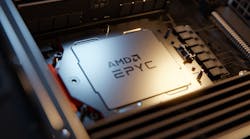Check out more Mobile World Congress 2023 coverage.
AMD brings a spate of news to its presence at Mobile World Congress 2023—more support for its 5G partner ecosystem from core to radio-access-network (RAN) applications, new test capabilities, and new 5G products.
Telco Solutions Testing Lab
With the formation of its Telco Solutions testing lab, AMD provides critical resources for operators and telco solution providers to test, validate, and scale computing resources to deliver on the ever-increasing demands from RAN and edge-to-core. The testing lab supports validation of end-to-end solutions, including both hardware and software to leverage the performance and power efficiencies of the latest AMD processors, adaptive SoCs, SmartNICs, FPGAs, and DPUs.
AMD chose the Viavi end-to-end testing suite to analyze, develop, and validate the impact of real-life conditions across an entire telco network. The Telco Solutions testing lab will enable traffic simulation and generation across core, CU/DU, edge, and RAN using both current and future AMD technologies. It will allow for full functional and performance testing that meets current and future generation ecosystem requirements. Based in Santa Clara, Calif., the Telco Solutions testing lab will bring in its first 5G ecosystem partners beginning Q2 of 2023.
RFSoC Devices for Emerging 4G/5G Growth Markets
AMD is expanding its Zynq UltraScale+ RFSoC digital front-end (DFE) portfolio with two additions to the family: the Zynq UltraScale+ RFSoC ZU63DR and Zynq UltraScale+ RFSoC ZU64DR devices. These new RFSoCs will enable the expansion and deployment of 4G/5G radios into markets around the globe where lower cost/power and spectrum-efficient radios are required to address increased wireless connectivity.
The Zynq UltraScale+ RFSoC ZU63DR specifically targets four transmit and four receive (4T4R) and dual-band, entry-level O-RAN radio-unit (O-RU) applications. The Zynq UltraScale+ RFSoC ZU64DR is aimed at eight transmit and eight receive (8T8R) O-RU applications using the 3rd Generation Partner Project (3GPP) split-8 option, which supports alternative and legacy radio-unit architectures. Both RFSoC devices leverage the deep DFE integration available in the flagship Zynq UltraScale+ RFSoC ZU67DR device and are expected to be in full production in Q2 of 2023.
Ecosystem Collaboration with Nokia
As part of AMD’s growing telco ecosystem, AMD and Nokia are jointly announcing an expanded collaboration using 4th Gen AMD EPYC6 processor-based servers to deliver Nokia Cloud RAN solutions to help communications service providers achieve their most stringent energy-efficiency goals. AMD and Nokia recognize the challenges faced by operators dealing with spiraling energy costs and the growing importance of meeting carbon-reduction targets at the core as well as the network edge.
Visit AMD at MWC in Hall 2, Stand 2M61 from February 27 to March 2, 2023.
Check out more Mobile World Congress 2023 coverage.
